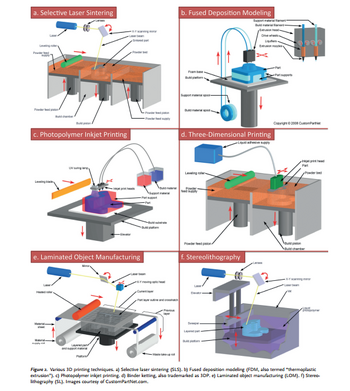Printing Processes and Technologies

3D printing is a crucial tool for the developers of microfluidic devices. Not all 3D printing techniques are used by microfluidic developers. "the term “3D printing”—considered to be synonymous with “solid freeform fabrication”—refers to a family of additive-based manufacturing techniques. Importantly, not all 3D printing techniques are suitable for microfluidics. The most widely used 3D printing techniques with relevance to microfluidics are selective laser sintering" (Au, Anthony K, Wilson Huynh, Lisa F. Horowitz, and Albert Folch). The different methods of 3D printing in microfluidics include Fabrication by Stereolithography, Fabrication by Selective Laser Sintering, Fabrication by photo polymer inkjet printing, fabrication by fused deposition modeling, and fabrication by laminated object manufacturing. These different methods of 3D printing have different levels of resolution and automation.
Selective Laser Sintering (SLS)
Fused Deposition Modeling (FDM)
Binder Jetting
Photopolymer Inkjet Printing
Laminated Object Manufacturing
Stereolithography
New Technologies (Paige Liu)
Two of the factors driving innovation in 3D printing for microfluidics are channel size and resolution,1.
Exploration into additive materials using other materials such as concrete and biomaterials has also been of interest2.
There are also some new methods of 3D printing that are being developed.
High Resolution 3D Printing Using a Customized Resin and Photolithography Printer
Using an adapted stereolithography (SLA) printer and a series of custom-formulated resins, a lab was able to create microchannels at up to 18x20 um resolution3. This method has not been reproduced in literature and definitely has yet to be scaled up, but it holds promise for the future of 3D printing microfluidic circuits.
(Will include some figures of the channel dimensions for scale from the paper)
Additive Manufacturing of Biomaterials
Additive manufacturing using biomaterials is a hot topic due to the obvious impact it would have on the development and manufacture of medical devices such as stents, artificial joints, etc. One of the driving forces of advancing additive manufacturing techniques for the production of biomedical devices is to reduce manufacturing costs and allow for rapid prototyping capabilities with less waste. The high variances in geometry from biological system to biological system (e.g. person to person) creates further demand for 3D printing type technologies, as the designs are easily customized in contrast to traditional manufacturing techniques.
One of the main challenges that come from adapting AM to biomaterials is removing powder/ other support type materials from the final product. Generally, any loose material could be problematic in-vitro since there could be problems with biocompatibility in a scattered vs. a conhesive final product4. Other challenges include high initial costs on the research and development side.
Computed Axial Lithography (CAL)
--> can stick this under photopolymerization
(Some technical details) (A cool video) (Go Bears)
Volumetrically photopolymerized structures as opposed to traditional layer-by-layer deposition methods5.
References
- 1Au, A. K., Huynh, W., Horowitz, L. F. & Folch, A. 3D-Printed Microfluidics. Angew. Chemie - Int. Ed. 55, 3862–3881 (2016). DOI: 10.1002/anie.201504382
- 2Ngo, T. D., Kashani, A., Imbalzano, G., Nguyen, K. T. Q. & Hui, D. Additive manufacturing (3D printing): A review of materials, methods, applications and challenges. Compos. Part B Eng. 143, 172–196 (2018). DOI: 10.1016/j.compositesb.2018.02.012
- 3Gong, H., Bickham, B. P., Woolley, A. T. & Nordin, G. P. Custom 3D printer and resin for 18 μm × 20 μm microfluidic flow channels. Lab Chip 17, 2899–2909 (2017). DOI: 10.1039/C7LC00644F
- 4Bose, S., Ke, D., Sahasrabudhe, H. & Bandyopadhyay, A. Additive manufacturing of biomaterials. Prog. Mater. Sci. 93, 45–111 (2018). DOI: 10.1016/j.pmatsci.2017.08.003
- 5Kelly, B. E. et al. Volumetric additive maufacturing via tomographic reconstruction. Science (80-. ). 126, 21 (2019). DOI: 10.1126/science.aau7114
References
Au, Anthony K, Wilson Huynh, Lisa F. Horowitz, and Albert Folch. "3d-printed Microfluidics." Angewandte Chemie International Edition. 55.12 (2016): 3862-3881. Print
Hausman, Kalani K, and Richard Horne. 3d Printing for Dummies. , 2014. Internet resource.
Kang, HW, SJ Lee, IK Ko, C Kengla, JJ Yoo, and A Atala. "A 3d Bioprinting System to Produce Human-Scale Tissue Constructs with Structural Integrity." Nature Biotechnology. 34.3 (2016): 312-9. Print.
Lee Lerner, K. "3D Printing." The Gale Encyclopedia of Science, edited by K. Lee Lerner and Brenda Wilmoth Lerner, 5th ed., vol. 8, Gale, 2014, p. 4383. Gale Virtual Reference Library, silk.library.umass.edu/login?url=http://go.galegroup.com/ps/i.do?p=GVRL&sw=w&u=mlin_w_umassamh&v=2.1&it=r&id=GALE%7CCX3727802429&asid=0eb5397745510438593a6c6b6c9698a1. Accessed 16 Feb. 2017.
Murphy, Sean V., and Anthony Atala. "3D Bioprinting of Tissues and Organs." Nature Biotechnology 32.8 (2014): 773-85. Web.
